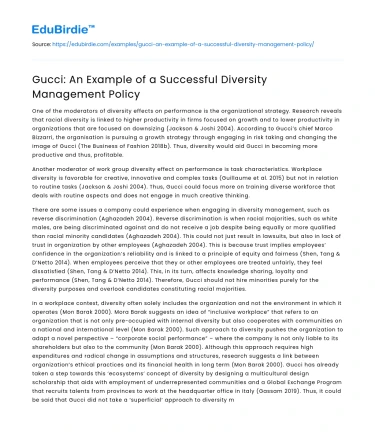One of the moderators of diversity effects on performance is the organizational strategy. Research reveals that racial diversity is linked to higher productivity in firms focused on growth and to lower productivity in organizations that are focused on downsizing (Jackson & Joshi 2004). According to Gucci’s chief Marco Bizzarri, the organisation is pursuing a growth strategy through engaging in risk taking and changing the image of Gucci (The Business of Fashion 2018b). Thus, diversity would aid Gucci in becoming more productive and thus, profitable.
Another moderator of work group diversity effect on performance is task characteristics. Workplace diversity is favorable for creative, innovative and complex tasks (Guillaume et al. 2015) but not in relation to routine tasks (Jackson & Joshi 2004). Thus, Gucci could focus more on training diverse workforce that deals with routine aspects and does not engage in much creative thinking.
Save your time!
We can take care of your essay
- Proper editing and formatting
- Free revision, title page, and bibliography
- Flexible prices and money-back guarantee
There are some issues a company could experience when engaging in diversity management, such as reverse discrimination (Aghazadeh 2004). Reverse discrimination is when racial majorities, such as white males, are being discriminated against and do not receive a job despite being equally or more qualified than racial minority candidates (Aghazadeh 2004). This could not just result in lawsuits, but also in lack of trust in organization by other employees (Aghazadeh 2004). This is because trust implies employees’ confidence in the organization’s reliability and is linked to a principle of equity and fairness (Shen, Tang & D’Netto 2014). When employees perceive that they or other employees are treated unfairly, they feel dissatisfied (Shen, Tang & D’Netto 2014). This, in its turn, affects knowledge sharing, loyalty and performance (Shen, Tang & D’Netto 2014). Therefore, Gucci should not hire minorities purely for the diversity purposes and overlook candidates constituting racial majorities.
In a workplace context, diversity often solely includes the organization and not the environment in which it operates (Mon Barak 2000). Mora Barak suggests an idea of “inclusive workplace” that refers to an organization that is not only pre-occupied with internal diversity but also cooperates with communities on a national and international level (Mon Barak 2000). Such approach to diversity pushes the organization to adapt a novel perspective – “corporate social performance” – where the company is not only liable to its shareholders but also to the community (Mon Barak 2000). Although this approach requires high expenditures and radical change in assumptions and structures, research suggests a link between organization’s ethical practices and its financial health in long term (Mon Barak 2000). Gucci has already taken a step towards this ‘ecosystems’ concept of diversity by designing a multicultural design scholarship that aids with employment of underrepresented communities and a Global Exchange Program that recruits talents from provinces to work at the headquarter office in Italy (Gassam 2019). Thus, it could be said that Gucci did not take a ‘superficial’ approach to diversity management and should focus on developing more of such initiatives.
In conclusion, it is evident that Gucci has made the right decision to employ diversity management initiatives, as they would not only help the organization restore its reputation, but also aid Gucci stay innovative, maintain or improve its financial performance, productivity, employee trust and loyalty. Moreover, Gucci proved to have a wide outlook on diversity, as it did not purely focus on internal diversity but also attempted to develop corporate-community relations. However, Gucci could still work on improving its “corporate social performance” and enhancing its standing. Furthermore, Gucci could still reconsider some elements of its cultural awareness program and training with regards to the research findings, such as employing “organizational diversity framework” and focusing on developing leadership skills and implementing a concept of “self-efficacy”. Gucci should also be aware and cautious of possible reverse discrimination and design a way to avoid it.
Through completing this project, I gained a deeper understanding of diversity management significance and realized the holistic and interconnected nature of business operations. Although the issue in hand was related to marketing, it was resolved through HR practices, which helped me understand the link between HR and organization’s strategy and goals. Moreover, I saw the importance the goals of financial performance play in constructing HR initiatives. This project made me realize that relationships between HR initiatives and a particular outcome are complex and depend on many variables that can be difficult to account for. One issue I have encountered is that some articles I have used were published more than 10 years ago, which suggests that the results may not be as relevant today due to change in generations and attitudes. Moreover, most of the research results are based on a western population, which makes me question whether the results would differ in other cultures and sparked my interest in the role of culture in HR. Lastly, I found the topic of diversity management to be particularly interesting to me, as I myself have grown up in an international environment and this could affect me in the future when I am seeking to be employed.






 Stuck on your essay?
Stuck on your essay?

